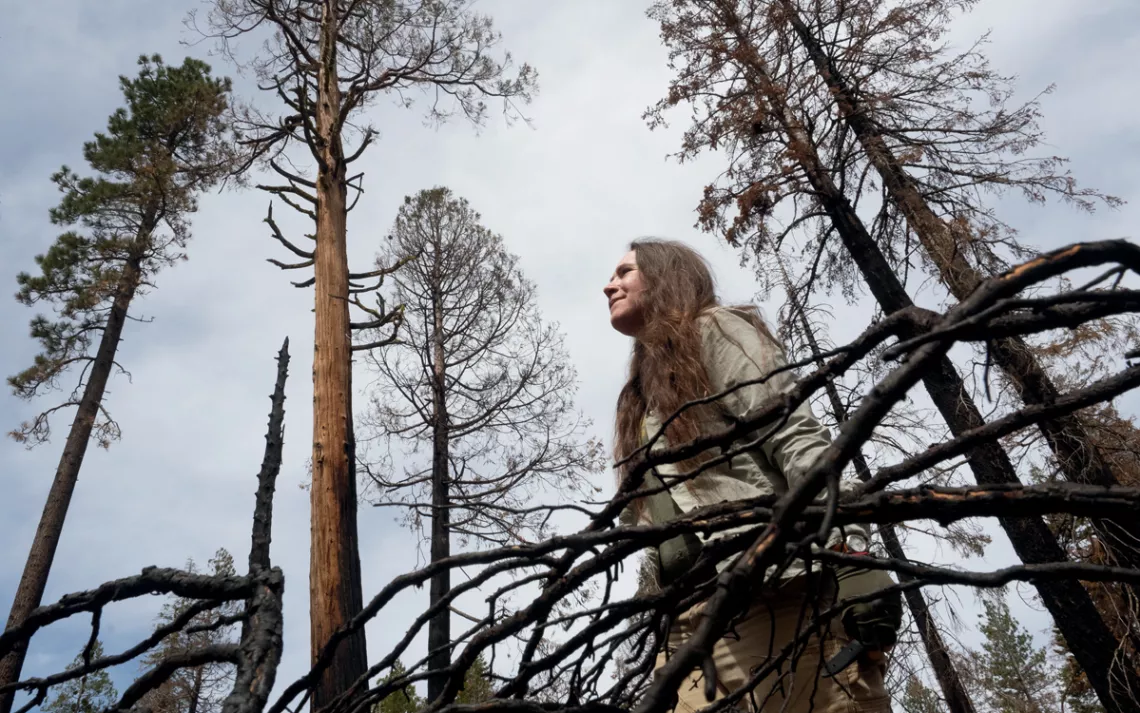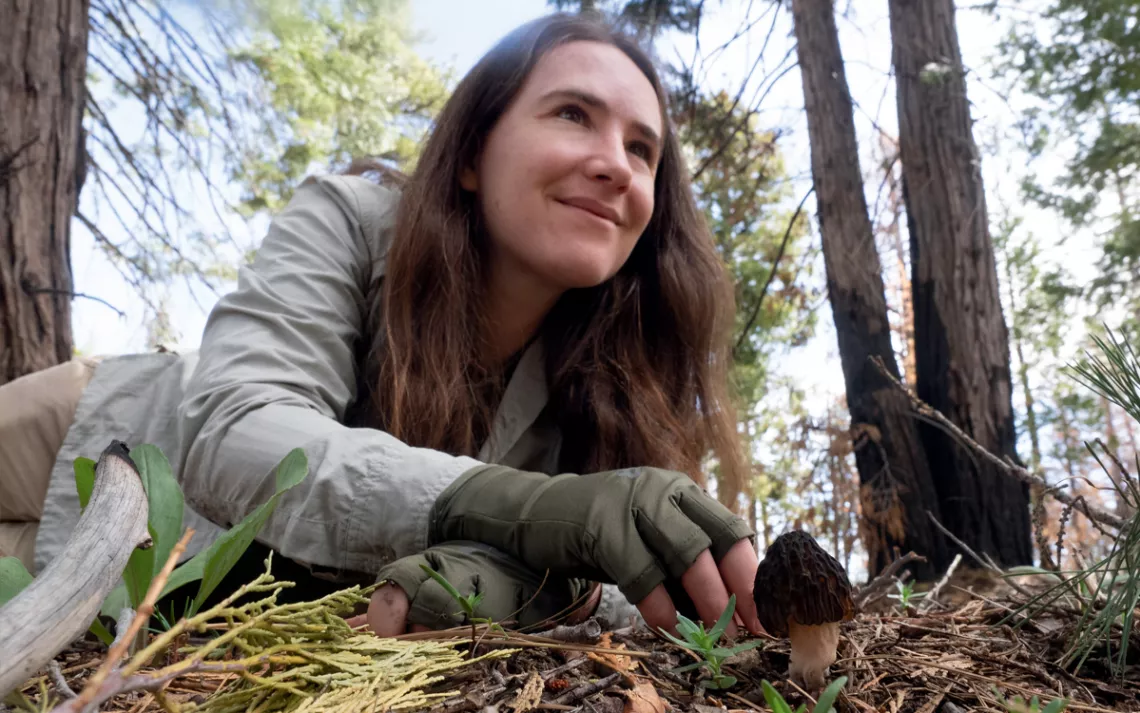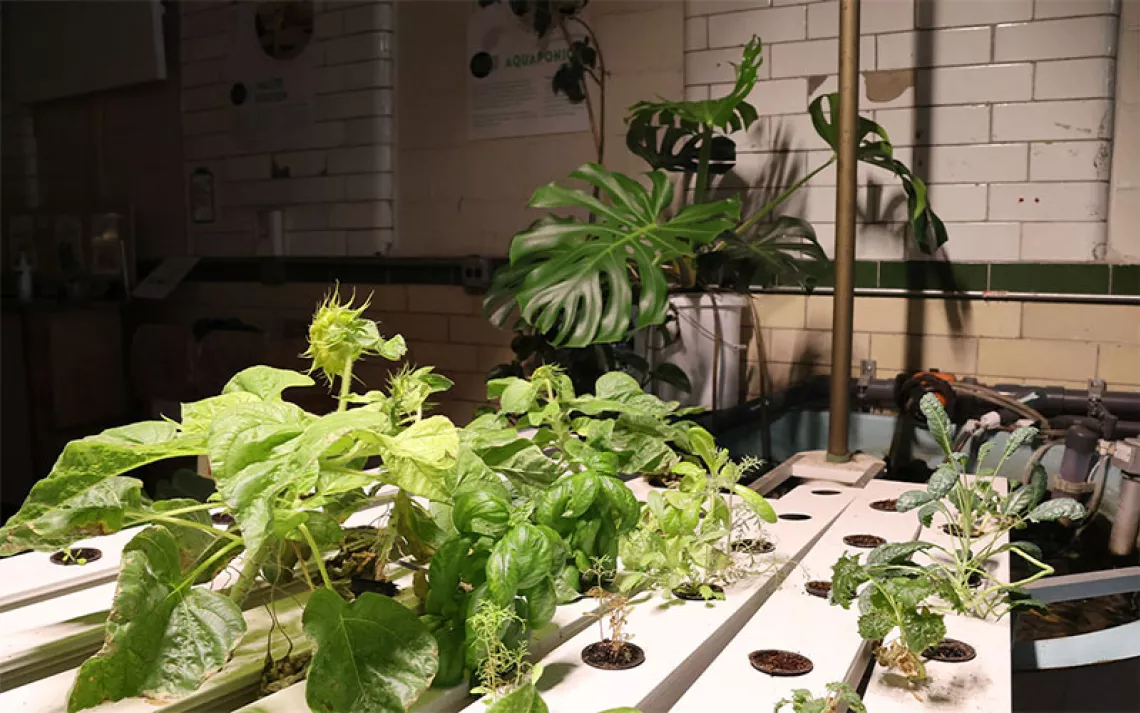When Life Gives you Wildfires, Go Looking for Morels
In which the author attempts to cope with fire season by eating her way through the burn zone

Thea Chesney smiles and reaches for a morel on the forest floor. | Photo by Kate Golden
On a spring day in the Sierra Nevada, seeking a silver lining to climate change and California going up in flames, I met up with Thea Chesney and climbed into her rig, a Volvo station wagon with a bumper sticker that read "Mycelium is the message." My quest was to find morels. Chesney, a forester with the US Forest Service, wanted to see what the woods had gotten up to since the Caldor Fire, which had burned through 221,835 acres in the fall of 2021. She had known this forest intimately beforehand, but now it was a whole new place. We pulled away from the thick greenery in the town of Pollock Pines and headed to the burn zone, near the American River's Silver Fork.

A hat holds an hour's worth of morel collecting. | Photo by Kate Golden
Chesney is not an academic mycologist, but she is the person such mycologists often call when they need help identifying a mushroom. "She spends a lot of time in the woods," one myco-professor told me, enviously. For a decade, Chesney has been writing a Sierra Nevada mushroom field guide on the side with two other researchers. It's taking a while, in part because fungi have stopped popping up where Chesney and her coauthors expect them to be—a possible sign of how fast the climate is changing.
Reasonable people choose study subjects they can reliably find. Also, people often eat morels instead of studying them.
The question of why morels fruit where they fruit, and when, has maddened many morel seekers. "Morels don't like to follow rules," Chesney said. The delicious, wrinkly, phallic fruiting body aboveground is merely the sex organ of the mycelium hidden underground. Some morel species fruit after fires; others don't. "Burn morels," as the fire followers are called, can hunker down as sclerotia: thick, hardy masses that can survive an autumn torching. The next spring, they will fruit, sometimes en masse. Ambitious mushroom hunters plan spring morel forays using the maps of the previous fall's fires.

Chesney inspects a mushroom near a roadside ditch. | Photo by Kate Golden

Sign up to receive Sierra News & Views
Get articles like this one sent directly to your inbox weekly.
With this action you affirm you want to receive Sierra Club communications and may vote on policy designated by the Sierra Club Board.
But much of the morel's basic biology is unknown, as is what the megafires of the past few years mean for California's morels. Mycology is a tiny field, and the genus Morchella (number of species: debatable, expanding) is fleeting and tricksy. Reasonable people choose study subjects they can reliably find. Also, people often eat morels instead of studying them. "I'm not excluding myself from that," Chesney said.
More broadly, we don't know what megafires mean for the entire kingdom of fungi. Ninety percent of fungi don't produce visible fruiting bodies, and mycologists have no real baseline for measuring their abundance. "There's just nobody looking, in most places," Chesney said. The study of mycology seemed to her about two centuries behind that of botany.
The most recent field study of fire and western morels came about after the 2013 Rim Fire burned through forest ecologist Andrew Larson's regular survey plots at Yosemite National Park. Larson, a morel-loving University of Montana professor, was already cataloging postfire vegetation and figured he might as well count the mushrooms too. The crispiest spots were the most morel-heavy, though that finding wasn't definitive, he said. Still, it gave me hope.

A squirrel's-eye view of a morel. | Photo by Kate Golden
Chesney pulled over into an area she had a feeling about. Six feet from the car, a black-and-gray thumb poked up an inch out of charcoal and needles. The presence of morels gave a new layer of meaning and possibility to the forest. The tree trunks around us were blackened, but the canopy—a mix of green and chestnut-brown needles—was only lightly toasted. Morels hid in twos and threes under scraggly two-foot pines. Slowly we filled Chesney's hat.
As we walked, Chesney spotted other mushrooms, some from impossible distances. Pyronema, a smear as orange as the fire it follows, is one of the few types of fungi that can consume charcoal. On a fingernail, Chesney joyously and delicately perched some tiny brown cup fungi, way too small to eat. She urged me to smell another postfire survivor, a Jeffrey pine: butterscotch and barbecue. She noted chartreuse wolf lichens, almost unkillable, on burned trunks, and a hollow stump sticking out of a strange black moat of charcoal. I had thought of fire as a binary thing that rips through and leaves a forest to cope with its consequences. But there it smoldered all winter, carving that moat. A giant sugar pine towering above the wreckage showed no signs of scorching. "'What fire? Nobody told me about any fire,'" Chesney deadpanned.
We drove the ridgeline, stopping short when Chesney spotted a morel in a ditch from 30 feet away; she had me hop out to snatch it up. The forest's changing color palette revealed how unevenly the fire had wandered through—lush green gave way to brown, which ceded to vast black-and-white areas as stark as a silent film. She turned down a dirt road and into a quiet cemetery of tall black dead things. No birds. Water flowed over mineral soil, with no tree roots alive to soak it up. "It's going to be a long time before this is forest again," Chesney said. But like Westley in The Princess Bride, it was only mostly dead: Tiny wild onions sprouted, and we whooped to find a verdant patch of grass where the water had collected.
Still, the scale of such high-intensity burn zones is "problematic for biodiversity in general," Chesney said. "Even plants adapted for fire can't tolerate this intensity." When Sydney Glassman, an assistant professor of fungal ecology at the University of California, Riverside, visited her survey plots after the 2018 Holy Fire, she found herself up to her shins in ash. Glassman analyzed the soil's fungal DNA in those burned plots and found that 80 percent of the biomass was gone and the species composition had changed entirely.
Chesney and I found morels in only the least-burned zones. So much for my silver lining. The best hunting was at the site of the Caples Fire, a 2019 controlled burn that had embarrassed the Forest Service by becoming uncontrolled. (Later on, the Caples proved its worth by leaving less fuel for Caldor to consume.) Here, the forest smelled green and was noisy with critters. We found blood-red snow plant, which steals food from trees via fungi rather than bothering to photosynthesize, and half-buried, softball-size cup fungi with lavender interiors. We gathered so many morels that we felt rich.
How to find morels

Obligatory disclaimer: Do not eat a wild mushroom unless you are 100 percent certain what it is. Morel look-alikes do exist. And don't nibble on raw morels, which have toxins that are destroyed by cooking. Be sure to follow the legal guidelines whenever foraging on public lands.
Get thee to a guidebook
Practice working through the identification keys in a mushroom guidebook with whatever fungi you find outside. Mushrooms Demystified is out-of-date taxonomically but still useful and entertaining.
Know your trees
Learn the species associated with morels in your area; hunting morels is often a matter of looking up for the right trees rather than down in search of a brown thing in the dirt.
Check prediction maps
If you live in an area untouched by fire, you may still have options. Not all morels are triggered by fire. People sell morel prediction maps online, but you can also look at burn maps, like those on the Cal Fire website, and go walking.
Find your mushroom people
Join a local mycology club to go on mushroom forays or to make friends with a morel hunter (though it may take years and heavy bribery before they take you to a special spot).
 The Magazine of The Sierra Club
The Magazine of The Sierra Club



